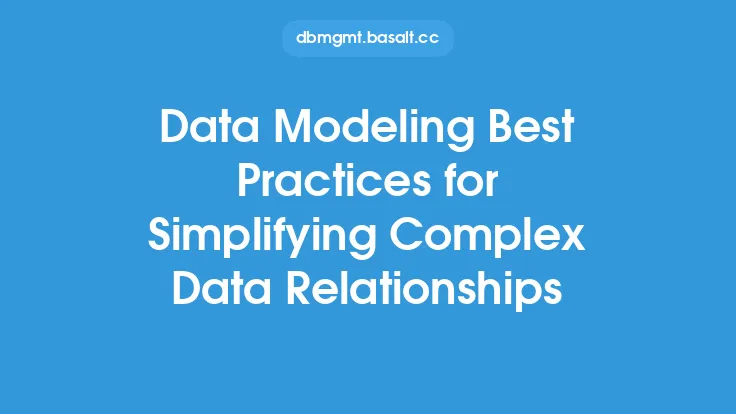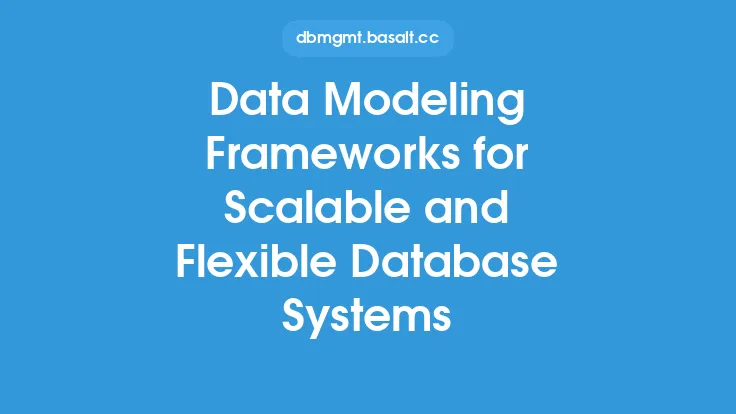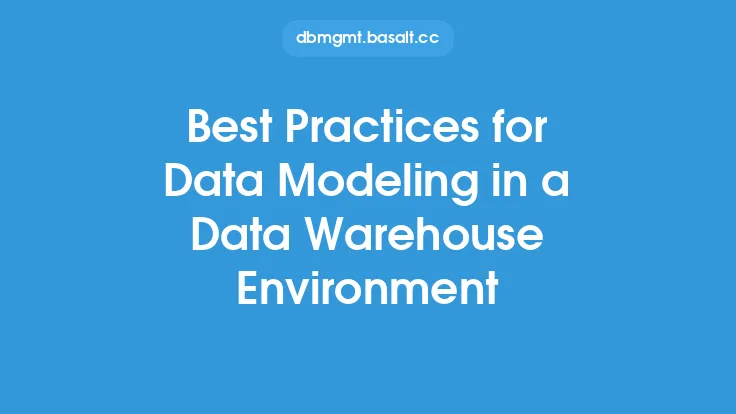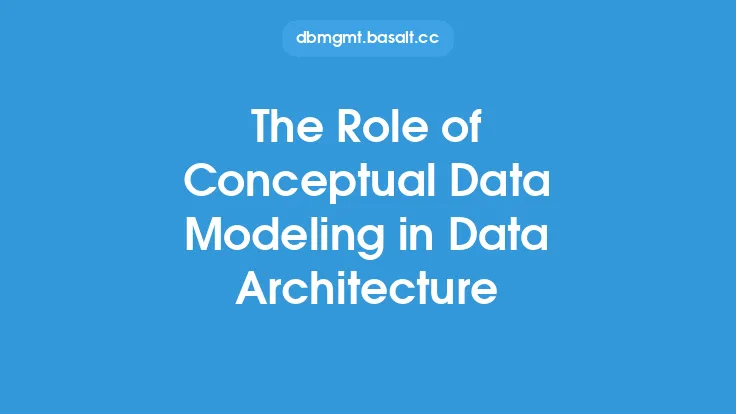When dealing with complex data systems, creating a robust and scalable data model is crucial for ensuring data consistency, reducing data redundancy, and improving data integrity. Conceptual data modeling is a critical step in the data modeling process that helps to identify the key entities, relationships, and concepts that are relevant to the business domain. In this article, we will explore the best approaches to conceptual data modeling for complex data systems, highlighting the key principles, techniques, and best practices that can help to ensure the success of your data modeling efforts.
Introduction to Conceptual Data Modeling Approaches
Conceptual data modeling involves creating a high-level representation of the business domain, focusing on the key concepts, entities, and relationships that are relevant to the business. There are several approaches to conceptual data modeling, including the Entity-Relationship (ER) model, the Object-Role Modeling (ORM) approach, and the Dimensional Modeling approach. Each of these approaches has its strengths and weaknesses, and the choice of approach will depend on the specific requirements of the business domain and the complexity of the data system.
Entity-Relationship Modeling
The Entity-Relationship (ER) model is a popular approach to conceptual data modeling that involves identifying the key entities, attributes, and relationships in the business domain. The ER model consists of three main components: entities, attributes, and relationships. Entities are the key concepts or objects in the business domain, such as customers, orders, or products. Attributes are the characteristics or properties of the entities, such as customer name, order date, or product price. Relationships are the connections between entities, such as a customer placing an order or a product being part of an order. The ER model is a powerful tool for conceptual data modeling, as it provides a simple and intuitive way to represent complex business domains.
Object-Role Modeling
The Object-Role Modeling (ORM) approach is another popular approach to conceptual data modeling that involves identifying the key objects, roles, and relationships in the business domain. The ORM approach is based on the idea that objects play roles in relationships, and that these roles can be used to define the relationships between objects. For example, a customer may play the role of buyer or seller in a transaction, and a product may play the role of goods or services. The ORM approach is particularly useful for modeling complex business domains that involve multiple roles and relationships.
Dimensional Modeling
The Dimensional Modeling approach is a specialized approach to conceptual data modeling that is designed specifically for data warehousing and business intelligence applications. The Dimensional Modeling approach involves identifying the key facts and dimensions in the business domain, and organizing them into a star or snowflake schema. Facts are the key metrics or measures in the business domain, such as sales or revenue, and dimensions are the characteristics or attributes of the facts, such as time, geography, or product. The Dimensional Modeling approach is particularly useful for modeling complex data systems that involve large amounts of data and require fast query performance.
Best Practices for Conceptual Data Modeling
Regardless of the approach used, there are several best practices that can help to ensure the success of conceptual data modeling efforts. These include:
- Start with a clear understanding of the business domain: Before beginning the conceptual data modeling process, it is essential to have a clear understanding of the business domain and the key concepts, entities, and relationships that are relevant to the business.
- Use a consistent notation: Using a consistent notation, such as the ER or ORM notation, can help to ensure that the conceptual data model is clear and unambiguous.
- Focus on the key concepts and relationships: The conceptual data model should focus on the key concepts and relationships in the business domain, rather than trying to model every detail.
- Use abstraction and generalization: Abstraction and generalization are powerful techniques for simplifying complex business domains and identifying the key concepts and relationships.
- Validate the model with stakeholders: Validating the conceptual data model with stakeholders, such as business users and subject matter experts, can help to ensure that the model is accurate and complete.
Common Challenges and Pitfalls
Conceptual data modeling can be a complex and challenging process, and there are several common challenges and pitfalls that can arise. These include:
- Over-modeling: Over-modeling occurs when the conceptual data model is too detailed or complex, and can lead to confusion and misunderstandings.
- Under-modeling: Under-modeling occurs when the conceptual data model is too simplistic or incomplete, and can lead to errors and omissions.
- Lack of stakeholder engagement: Failing to engage with stakeholders, such as business users and subject matter experts, can lead to a conceptual data model that is inaccurate or incomplete.
- Inconsistent notation: Using an inconsistent notation can lead to confusion and misunderstandings, and can make it difficult to communicate the conceptual data model to others.
Tools and Techniques for Conceptual Data Modeling
There are several tools and techniques that can be used to support conceptual data modeling efforts. These include:
- Data modeling software: Data modeling software, such as ER/Studio or PowerDesigner, can provide a range of features and functions to support conceptual data modeling, including entity-relationship diagrams, object-role modeling, and dimensional modeling.
- Business intelligence tools: Business intelligence tools, such as Tableau or Power BI, can provide a range of features and functions to support data analysis and reporting, and can be used to validate and refine the conceptual data model.
- Collaboration tools: Collaboration tools, such as Microsoft Teams or Slack, can provide a range of features and functions to support stakeholder engagement and communication, and can be used to facilitate the conceptual data modeling process.
Conclusion
Conceptual data modeling is a critical step in the data modeling process that helps to identify the key entities, relationships, and concepts that are relevant to the business domain. By using a combination of approaches, techniques, and best practices, data modelers can create a robust and scalable conceptual data model that meets the needs of the business and supports the development of complex data systems. Whether using the ER model, ORM approach, or Dimensional Modeling approach, the key to successful conceptual data modeling is to start with a clear understanding of the business domain, use a consistent notation, focus on the key concepts and relationships, and validate the model with stakeholders. By following these best practices and using the right tools and techniques, data modelers can create a conceptual data model that is accurate, complete, and effective in supporting the needs of the business.





